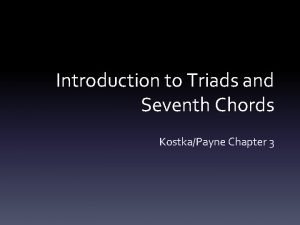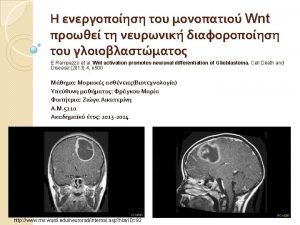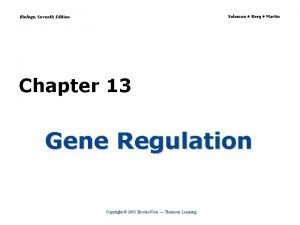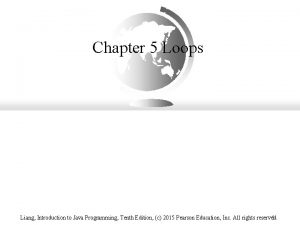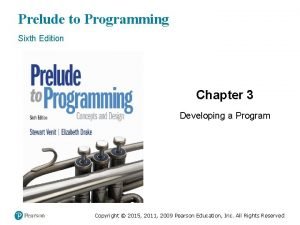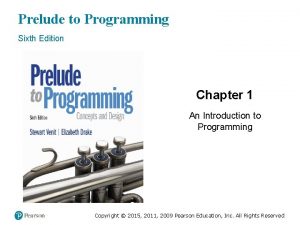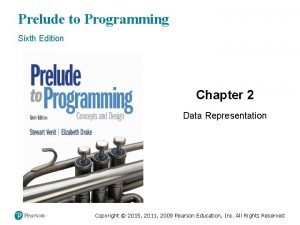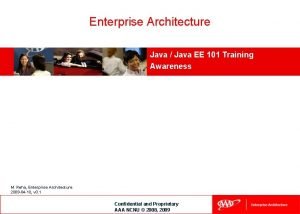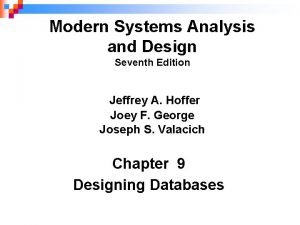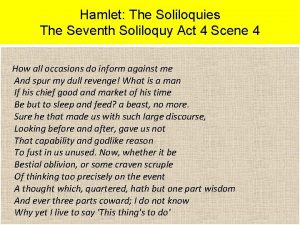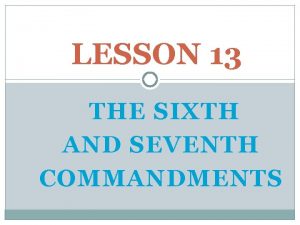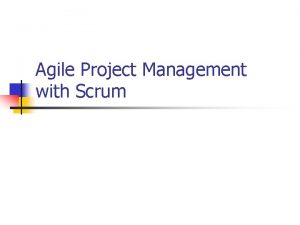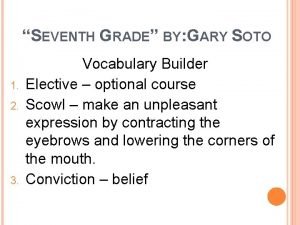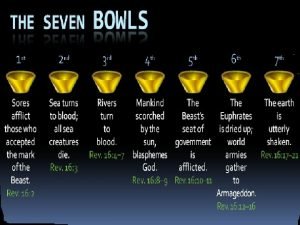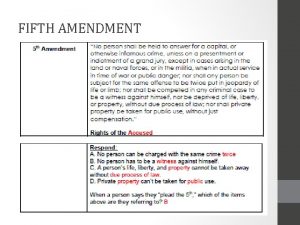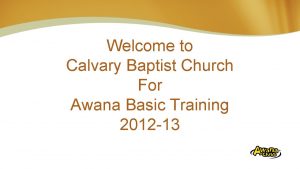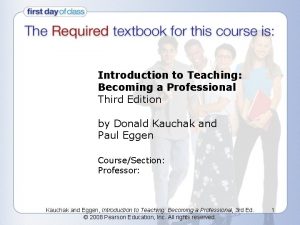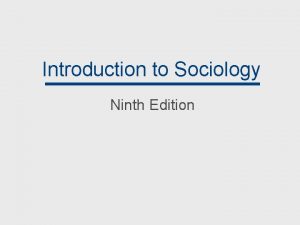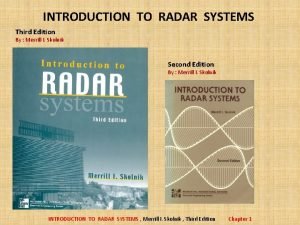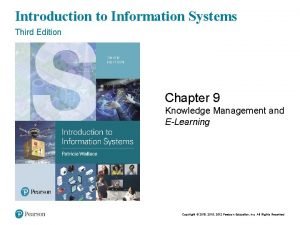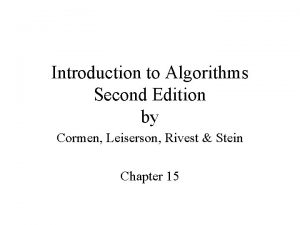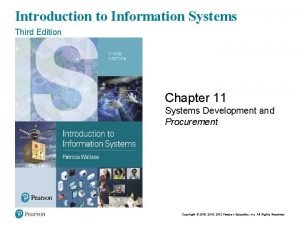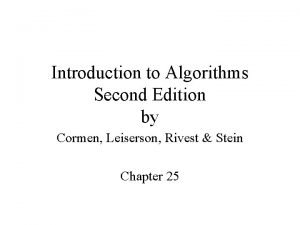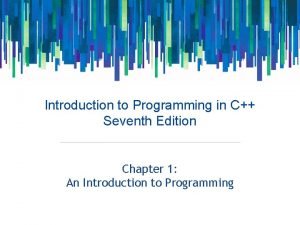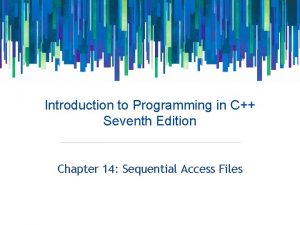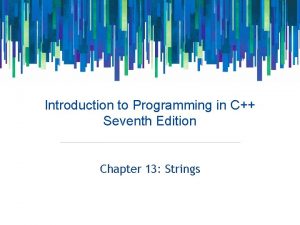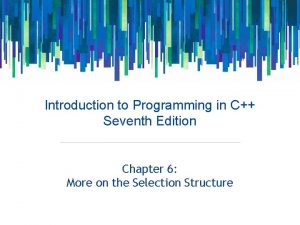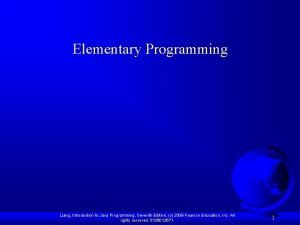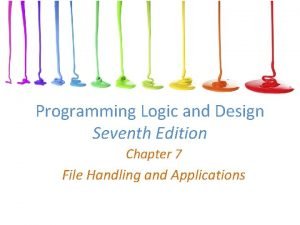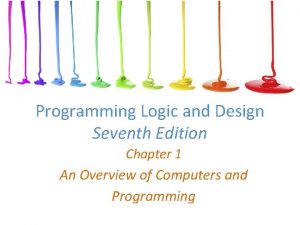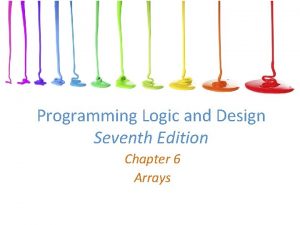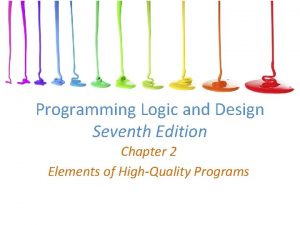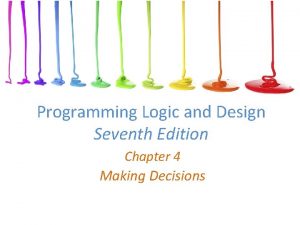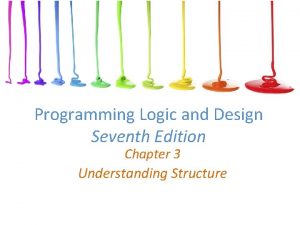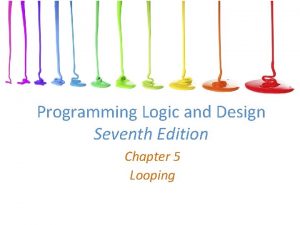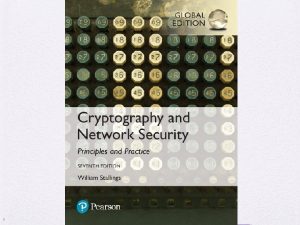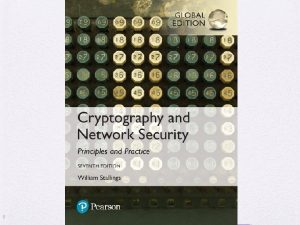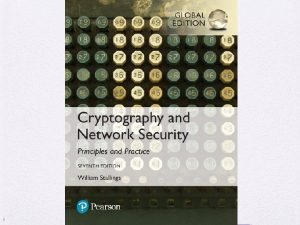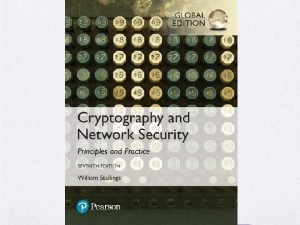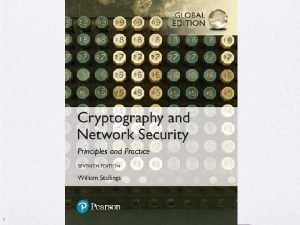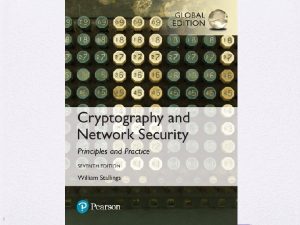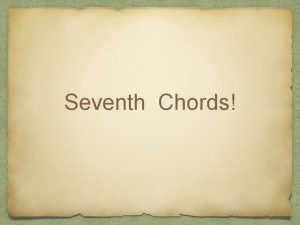Introduction to Programming in C Seventh Edition Chapter


























































- Slides: 58

Introduction to Programming in C++ Seventh Edition Chapter 9: Value-Returning Functions

Objectives • Use the sqrt function to return the square root of a number • Generate random numbers • Create and invoke a function that returns a value • Pass information by value to a function • Write a function prototype • Understand a variable’s scope and lifetime An Introduction to Programming with C++, Seventh Edition 2

Functions • A function is a block of code that performs a task • Every C++ program contains at least one function (main) – Most contain many functions • Some functions are built-in functions (part of C++): defined in language libraries • Others, called program-defined functions, are written by programmers; defined in a program • Functions allow for blocks of code to be used many times in a program without having to duplicate code An Introduction to Programming with C++, Seventh Edition 3

Functions (cont’d. ) • Functions also allow large, complex programs to be broken down into small, manageable sub-tasks • Each sub-task is solved by a function, and thus different people can write different functions • Many functions can then be combined into a single program • Typically, main is used to call other functions, but any function call any other function An Introduction to Programming with C++, Seventh Edition 4

Functions (cont’d. ) Figure 9 -1 Illustrations of value-returning and void functions An Introduction to Programming with C++, Seventh Edition 5

Value-Returning Functions • All functions are either value-returning or void • All value-returning functions perform a task and then return precisely one value • In most cases, the value is returned to the statement that called the function • Typically, a statement that calls a function assigns the return value to a variable – However, a return value could also be used in a comparison or calculation or could be printed to the screen An Introduction to Programming with C++, Seventh Edition 6

The Hypotenuse Program • Program that calculates and displays the length of a right triangle hypotenuse • Program uses Pythagorean theorem – Requires squaring and taking square root • pow function can be used to square • sqrt function can be used to take square root • Both are built-in value-returning functions An Introduction to Programming with C++, Seventh Edition 7

The Hypotenuse Program (cont’d. ) Figure 9 -2 Problem specification, calculation example, and IPO chart for the hypotenuse program An Introduction to Programming with C++, Seventh Edition 8

The Hypotenuse Program (cont’d. ) Figure 9 -3 Flowchart of the hypotenuse program An Introduction to Programming with C++, Seventh Edition 9

Finding the Square Root of a Number • sqrt function is a built-in value-returning function that returns a number’s square root as a double • Definition contained in cmath library – Program must contain #include <cmath> to use it • Syntax: sqrt(x), in which x is a double or float – Here, x is an actual argument, which is an item of information a function needs to perform its task • Actual arguments are passed to a function when called An Introduction to Programming with C++, Seventh Edition 10

Finding the Square Root of a Number (cont’d. ) Figure 9 -4 How to use the sqrt function An Introduction to Programming with C++, Seventh Edition 11

Finding the Square Root of a Number (cont’d. ) Figure 9 -5 IPO chart information and C++ instructions for the hypotenuse program An Introduction to Programming with C++, Seventh Edition 12

Finding the Square Root of a Number (cont’d. ) Figure 9 -6 Hypotenuse program An Introduction to Programming with C++, Seventh Edition 13

Finding the Square Root of a Number (cont’d. ) Figure 9 -7 Sample run of hypotenuse program An Introduction to Programming with C++, Seventh Edition 14

The Random Addition Problems Program • Program that generates addition problems of the form “What is the sum of x and y? ” • Asks user to input answer, compares answer to correct answer, and displays whether correct or not • Program requires generating random integers between 1 and 10 An Introduction to Programming with C++, Seventh Edition 15

The Random Addition Problems Program (cont’d. ) Figure 9 -8 Problem specification for random addition problems program An Introduction to Programming with C++, Seventh Edition 16

The Random Addition Problems Program (cont’d. ) Figure 9 -8 IPO chart for random addition problems program An Introduction to Programming with C++, Seventh Edition 17

The Random Addition Problems Program (cont’d. ) Figure 9 -9 Flowchart for random addition problems program An Introduction to Programming with C++, Seventh Edition 18

Generating Random Integers • C++ provides a pseudo-random number generator – Produces a sequence of numbers that meet certain statistical requirements for randomness – Numbers chosen uniformly from finite set of numbers – Not truly random but sufficient for practical purposes • Random number generator in C++: rand function – Returns an integer between 0 and RAND_MAX, inclusive – RAND_MAX is a built-in constant (>= 32767) An Introduction to Programming with C++, Seventh Edition 19

Generating Random Integers (cont’d. ) • rand function’s syntax: rand() – Doesn’t require any actual arguments, but parentheses are still required • Expression: lower. Bound + rand() % (upper. Bound – lower. Bound + 1) – Allows ranges other than 0 to RAND_MAX to be used – Range is upper. Bound to lower. Bound • Initialize random number generator each time – Otherwise, will produce the same sequence An Introduction to Programming with C++, Seventh Edition 20

Generating Random Integers (cont’d. ) Figure 9 -11 How to generate random integers within a specific range An Introduction to Programming with C++, Seventh Edition 21

Generating Random Integers (cont’d. ) Figure 9 -11 How to generate random integers within a specific range (cont’d. ) An Introduction to Programming with C++, Seventh Edition 22

Generating Random Integers (cont’d. ) • Use srand function (a void function) to initialize random number generator • Syntax: srand(seed), in which seed is an integer actual argument that represents the starting point of the generator – Commonly initialized using the time function • Ensures unique sequence of numbers for each program run An Introduction to Programming with C++, Seventh Edition 23

Generating Random Integers (cont’d. ) • time function is a value-returning function that returns current time in number of seconds since January 1, 1970 – Returns a time_t object, so must be cast to an integer before passing to srand – Program must contain #include <ctime> directive to use it An Introduction to Programming with C++, Seventh Edition 24

Generating Random Integers (cont’d. ) Figure 9 -12 How to use the srand function An Introduction to Programming with C++, Seventh Edition 25

Generating Random Integers (cont’d. ) Figure 9 -13 IPO chart information and C++ instructions for the random addition problems program An Introduction to Programming with C++, Seventh Edition 26

Generating Random Integers (cont’d. ) Figure 9 -13 IPO chart information and C++ instructions for the random addition problems program (cont’d. ) An Introduction to Programming with C++, Seventh Edition 27

Generating Random Integers (cont’d. ) Figure 9 -14 Random addition problems program An Introduction to Programming with C++, Seventh Edition 28

Generating Random Integers (cont’d. ) Figure 9 -14 Random addition problems program (cont’d. ) An Introduction to Programming with C++, Seventh Edition 29

Generating Random Integers (cont’d. ) Figure 9 -15 Sample run of random addition problems program An Introduction to Programming with C++, Seventh Edition 30

Creating Program-Defined Value. Returning Functions • A program-defined value-returning function definition is composed of a header and a body • Header (first line) contains return data type, name of function, and an optional parameter. List – Rules for function names are same as for variables – Good idea to use meaningful names that describe function’s purpose – Memory locations in parameter. List are called formal parameters • Each stores an item of information passed to the function when it is called An Introduction to Programming with C++, Seventh Edition 31

Creating Program-Defined Value. Returning Functions (cont’d. ) • Function body contains instructions for performing the function’s assigned task • Surrounded by braces ({}) • Last statement is usually the return statement – Returns one value (must match return data type in function header) • After return statement is processed, program execution continues in calling function • Good idea to include comment (such as //end of function. Name) to mark end of function An Introduction to Programming with C++, Seventh Edition 32

Creating Program-Defined Value. Returning Functions (cont’d. ) Figure 9 -16 IPO charts for modified random addition problems program An Introduction to Programming with C++, Seventh Edition 33

Creating Program-Defined Value. Returning Functions (cont’d. ) Figure 9 -16 IPO charts for modified random addition problems program (cont’d. ) An Introduction to Programming with C++, Seventh Edition 34

Creating Program-Defined Value. Returning Functions (cont’d. ) Figure 9 -17 How to create a program-defined value-returning function An Introduction to Programming with C++, Seventh Edition 35

Creating Program-Defined Value. Returning Functions (cont’d. ) Figure 9 -17 How to create a program-defined value-returning function (cont’d. ) An Introduction to Programming with C++, Seventh Edition 36

Calling a Function • • A function must be called (invoked) to perform its task main is automatically called when program is run Other functions must be called by a statement Syntax for calling a function: function. Name([argument. List]); – argument. List is list of actual arguments (if any) – An actual argument can be a variable, named constant, literal constant, or keyword An Introduction to Programming with C++, Seventh Edition 37

Calling a Function (cont’d. ) • Value-returning functions are typically called from statements that: – Assign the return value to a variable – Use the return value in a calculation or comparison – Display the return value • A call to a void function is an independent statement because void functions do not return values An Introduction to Programming with C++, Seventh Edition 38

Calling a Function (cont’d. ) • C++ allows you to pass either a variable’s value or its address to a function • Passing a variable’s value is referred to as passing by value • Passing a variable’s address is referred to as passing by reference • Default is passing by value • Number, data type, and ordering of actual arguments must match the formal parameters in function header – Names do not need to match (different names are better) An Introduction to Programming with C++, Seventh Edition 39

Calling a Function (cont’d. ) Figure 9 -18 How to call a function An Introduction to Programming with C++, Seventh Edition 40

Calling a Function (cont’d. ) Figure 9 -18 How to call a function (cont’d. ) An Introduction to Programming with C++, Seventh Edition 41

Calling a Function (cont’d. ) Figure 9 -19 Function calls and function definitions An Introduction to Programming with C++, Seventh Edition 42

Calling a Function (cont’d. ) Figure 9 -20 IPO chart information and C++ instructions for the modified random addition problems program An Introduction to Programming with C++, Seventh Edition 43

Calling a Function (cont’d. ) Figure 9 -20 IPO chart information and C++ instructions for the modified random addition problems program (cont’d. ) An Introduction to Programming with C++, Seventh Edition 44

Calling a Function (cont’d. ) Figure 9 -20 IPO chart information and C++ instructions for the modified random addition problems program (cont’d. ) An Introduction to Programming with C++, Seventh Edition 45

Calling a Function (cont’d. ) Figure 9 -20 IPO chart information and C++ instructions for the modified random addition problems program (cont’d. ) An Introduction to Programming with C++, Seventh Edition 46

Function Prototypes • When a function definition appears below the main function, you must enter a function prototype above the main function • A function prototype is a statement that specifies the function’s name, data type of its return value, and data type of each of its formal parameters (if any) – Names for the formal parameters are not required • Programmers usually place function prototypes at beginning of program, after the #include directives An Introduction to Programming with C++, Seventh Edition 47

Function Prototypes (cont’d. ) Figure 9 -21 How to write a function prototype An Introduction to Programming with C++, Seventh Edition 48

Function Prototypes (cont’d. ) Figure 9 -22 Modified random addition problems program An Introduction to Programming with C++, Seventh Edition 49

Function Prototypes (cont’d. ) Figure 9 -22 Modified random addition problems program (cont’d. ) An Introduction to Programming with C++, Seventh Edition 50

The Scope and Lifetime of a Variable • A variable’s scope indicates where in the program the variable can be used • A variable’s lifetime indicates how long the variable remains in the computer’s internal memory • Both scope and lifetime are determined by where you declare the variable in the program • Variables declared within a function and those that appear in a function’s parameter. List have a local scope and are referred to as local variables An Introduction to Programming with C++, Seventh Edition 51

The Scope and Lifetime of a Variable (cont’d. ) • Local variables can be used only by the function in which they are declared or in whose parameter. List they appear – Remain in internal memory until the function ends • Global variables are declared outside of any function in the program – Remain in memory until the program ends • Any statement can use a global variable An Introduction to Programming with C++, Seventh Edition 52

The Scope and Lifetime of a Variable (cont’d. ) • Declaring a variable as global can allow unintentional errors to occur – e. g. , a function that should not have access to the variable inadvertently changes the variable’s contents • You should avoid using global variables unless necessary • If more than one function needs to access the same variable, it is better to create a local variable in one function and pass it to other functions that need it An Introduction to Programming with C++, Seventh Edition 53

Summary • Functions – Allow programmers to avoid duplicating code – Allow for large, complex programs to be broken into small, manageable tasks • Some functions are built into the language, and others are program-defined • All functions are either value-returning or void • A value-returning function returns one value – Value returned to statement that called the function • A void function returns no value An Introduction to Programming with C++, Seventh Edition 54

Summary (cont’d. ) • Use the sqrt function to find the square root of a number • Items in parentheses in a function call are called actual arguments • The rand function is used to generate random numbers – Returns an integer between 0 and RAND_MAX • srand function is used to initialize rand function – time function usually used as seed (starting point) An Introduction to Programming with C++, Seventh Edition 55

Summary (cont’d. ) • Function definition composed of header and body • Header specifies function name, return data type, and formal parameter names and types (if any) – Data types and ordering of formal parameters must match data types and ordering of actual arguments • Body contains instructions for performing the function’s assigned task – Surrounded by braces ({}) • return statement returns the result of an expression to the calling function An Introduction to Programming with C++, Seventh Edition 56

Summary (cont’d. ) • You call a function by including its name and actual arguments (if any) in a statement • Variables in C++ are passed by value by default • A function prototype must be provided for each function defined below the main function • Scope of a variable indicates where in the program it can be used • Lifetime of a variable indicates how long it will stay in internal memory An Introduction to Programming with C++, Seventh Edition 57

Summary (cont’d. ) • Local variables can be used only within the function in which they are declared or in whose parameter. List they appear – Remain in memory until the function ends • Global variables can be used anywhere – Remain in memory until the program ends • If more than one memory location have the same name, position of the statement in which the name is used determines which location is used An Introduction to Programming with C++, Seventh Edition 58
 Chapter 3 introduction to triads and seventh chords
Chapter 3 introduction to triads and seventh chords 3 layers of muscle
3 layers of muscle Database system concepts seventh edition
Database system concepts seventh edition Principles of management information system
Principles of management information system Molecular biology of the cell seventh edition
Molecular biology of the cell seventh edition Biology seventh edition
Biology seventh edition Introduction to java programming 10th edition quizzes
Introduction to java programming 10th edition quizzes Mis chapter 6
Mis chapter 6 Using mis 10th edition
Using mis 10th edition Computer programming chapter 1
Computer programming chapter 1 Chapter 1 introduction to computers and programming
Chapter 1 introduction to computers and programming Chapter 1 introduction to computers and programming
Chapter 1 introduction to computers and programming Chapter 1 introduction to computers and programming
Chapter 1 introduction to computers and programming Prelude to programming 6th edition
Prelude to programming 6th edition Prelude to programming 6th edition
Prelude to programming 6th edition Prelude to programming 6th edition
Prelude to programming 6th edition Java ee 101
Java ee 101 Expert systems: principles and programming, fourth edition
Expert systems: principles and programming, fourth edition Perbedaan linear programming dan integer programming
Perbedaan linear programming dan integer programming Greedy programming vs dynamic programming
Greedy programming vs dynamic programming Runtime programming
Runtime programming Linear vs integer programming
Linear vs integer programming Programing adalah
Programing adalah The devil from seventh grade 1960
The devil from seventh grade 1960 In the story, how is the seventh man characterized?
In the story, how is the seventh man characterized? You shall not steal
You shall not steal The fourth circle of hell
The fourth circle of hell Seventh-day adventist leadership structure
Seventh-day adventist leadership structure Brave seventh grade viking warrior
Brave seventh grade viking warrior The seventh man by haruki murakami
The seventh man by haruki murakami Article 9 of the creed
Article 9 of the creed Oranges'' by gary soto worksheet
Oranges'' by gary soto worksheet Seventh normal form
Seventh normal form Hamlet's 7th soliloquy analysis
Hamlet's 7th soliloquy analysis Kids classes in riverside seventh day baptist church
Kids classes in riverside seventh day baptist church The fifth, sixth, seventh, and eighth amendments protect *
The fifth, sixth, seventh, and eighth amendments protect * Seventh day adventist church
Seventh day adventist church Sixth and seventh commandments
Sixth and seventh commandments At the seventh sprint review the stakeholders
At the seventh sprint review the stakeholders Seventh grade by gary soto character traits
Seventh grade by gary soto character traits The 7 trumpets sound
The 7 trumpets sound Facial nerve branches
Facial nerve branches What's the 5th amendment
What's the 5th amendment Kids activity in riverside seventh day baptist church
Kids activity in riverside seventh day baptist church Marketing an introduction 6th canadian edition
Marketing an introduction 6th canadian edition Introduction to teaching 6th edition
Introduction to teaching 6th edition Introduction to sociology 9th edition
Introduction to sociology 9th edition Introduction to radar systems skolnik
Introduction to radar systems skolnik Introduction to information systems 6th edition
Introduction to information systems 6th edition Fundamentals of information systems chapter 1
Fundamentals of information systems chapter 1 Microbiology an introduction 9th edition
Microbiology an introduction 9th edition Introduction to information systems 3rd edition
Introduction to information systems 3rd edition Introduction to management information systems 5th edition
Introduction to management information systems 5th edition Food and beverage directors expect a pour cost of
Food and beverage directors expect a pour cost of Introduction to hospitality 7th edition
Introduction to hospitality 7th edition John r walker introduction to hospitality management
John r walker introduction to hospitality management Introduction to algorithms 2nd edition
Introduction to algorithms 2nd edition Introduction to information systems 3rd edition
Introduction to information systems 3rd edition Introduction to algorithms 2nd edition
Introduction to algorithms 2nd edition
